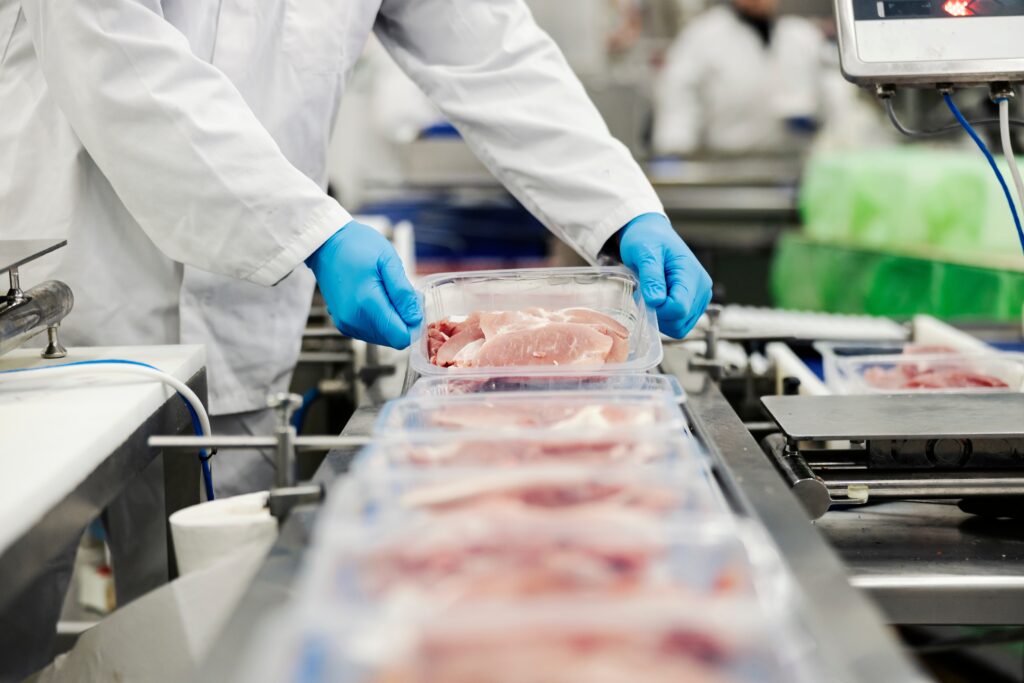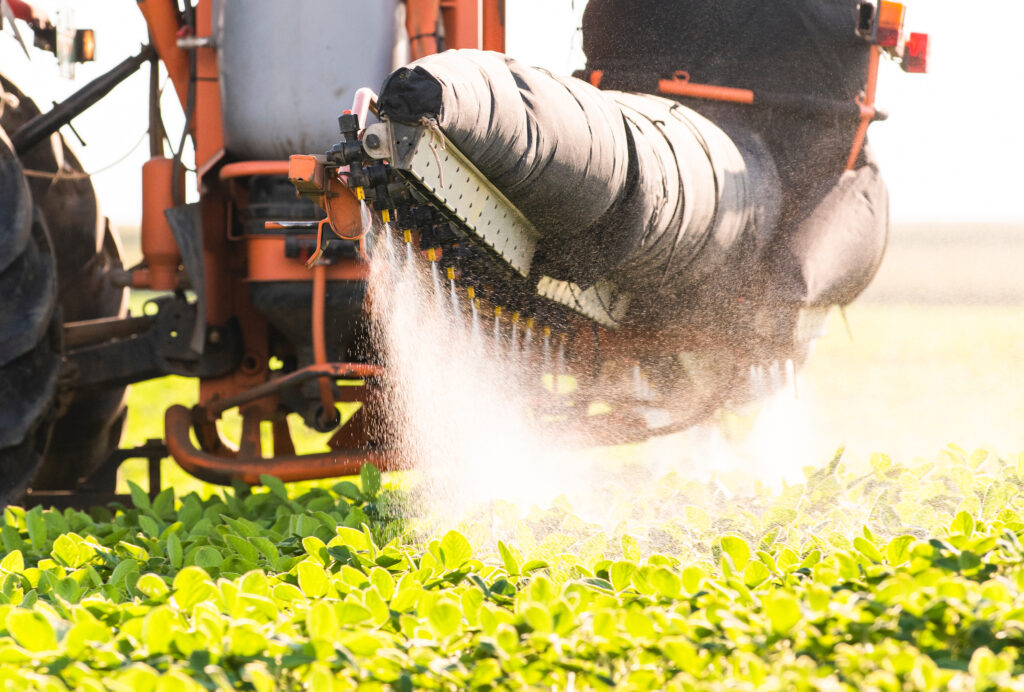By Gary Smith and Keith Belk, Colorado State University
In 1906, the Meat Inspection Act (MIA) assigned responsibility for food-safety oversight of meat from cattle, swine, sheep, and goats to the USDA; since then, the MIA was expanded to cover poultry, egg products, and catfish, but it does not cover milk, eggs, or milk products.1 MIA is administered by the Food Safety & Inspection Service (FSIS) and covers products in interstate and foreign commerce. Some States have “equivalent to federal MIA” programs.1
Also in 1906, the Food and Drug Act assigned responsibility for safety of “all other foods” to the Food & Drug Administration (FDA) of USDHHS.2 The FDA has regulatory authority over milk, milk products, eggs, fruits, vegetables, grains, and nuts plus wild animal meat, fish, and game that are in interstate and foreign commerce.2
In 1982, because neither FSIS-USDA nor FDA-USDHHS have intrastate commerce jurisdiction, FDA developed the Food Code to help Local and State Health Departments set uniform food-safety standards.3 The Food Code is updated every two years at the National Conference on Food Protection.3
Methods of Food Safety Oversight by FSIS and FDA
Food-safety oversight by FSIS-USDA, FDA-USDHHS, and State/Local Health Departments (SLHD) can include…
- Visual inspection of cleanliness of processing, holding, and conveyance equipment/facilities (FSIS, FDA, SLHD).
- Constant visual inspection during all processing (FSIS and some SLHDs).
- Periodic chemical and/or microbiological testing of raw materials, environments, and finished products (FSIS, FDA, and some SLHDs).
- Notifications of the public that certain food products are potentially or actually dangerous or unsafe (FSIS, FDA, and some SLHDs).1,2,3
Food-safety oversight for food products entering the USA from foreign sources is the responsibility of FSIS and the FDA, and consists only of…
- Visual inspection of cleanliness of conveyance equipment/facilities.
- Periodic chemical and/or microbiological testing of raw materials, environments, and finished products.
- Notifications of the public that certain food products are potentially or actually dangerous or unsafe.1,2,4
Early Concerns and Inspections in Food Safety
In 1906, we were concerned about filth; dirt; vermin; hair; worms in apples; weevils in grain; spoilage during storage; pus/feces/urine on or in animal-sourced foods; and cross-species transfers of tapeworms, parasites, and disease-causing microorganisms (e.g., Brucella abortus, Mycobacterium tuberculosis).5,6
FSIS oversight of safety for the food it regulates was largely centered on “during processing/before entering commerce.”6 Prior to and during processing and holding, government inspectors discarded unsanitary or unhealthful foods based solely on things they saw or smelled.6 Some histological testing was performed to detect parasites in meat (e.g., Cysticercus bovis, Trichinella spiralis).
Some chemical testing was done, not for safety but for adulteration (e.g., excess water, fat, or fillers).6 Some microbiological testing was done (e.g., survival of pathogens in inadequately pasteurized milk).6
Evolution of Food Safety Standards and FSMA
Prior to passage of the Food Safety Modernization Act (FSMA) in January, 2011, there were some disparities between the FSIS vs. FDA methodologies regarding oversight.4 FSMA gave FDA approval to make certain corrections (e.g., adding HACCP-like criteria to their Food Safety Plans).5 FDA’s introduction of Preventive Controls For Human Foods (PCHF) has greatly improved the safety of our nation’s food supply.
Much has changed in the 117 years since passage of the Meat Inspection and Food and Drug Acts. There is much closer scrutiny of the cleanliness of workers, facilities, and equipment; more vigilant adherence to Sanitation and Good Manufacturing Practices; and use of ATP luminometers, microbiological testing, and swab-a-thons to verify/validate the science of hygiene.7

Inspection Requirements and Food Safety Assessments
Establishments that generate food regulated by FSIS must have inspectors on-site at all times the plant is operating. There are 70 known diseases of animals that can be transmitted to humans; included among these are Anthrax, Undulant Fever (Brucellosis), Trichinosis, and Tuberculosis.8
FSIS Inspectors visually examine live animals, carcasses, and organs for symptoms of these diseases and condemn those that show signs of such infections.9 Inspectors also oversee the conduct of workers in the plant to make sure they don’t allow contamination of meat, organs, or processed products with filth, fluids, adulterants, fillers, or undesirable microbes.9
If Inspectors find faults, they issue a Non-Compliance Report (NR), to which the plant must respond immediately.3 Periodically, FSIS performs a Food Safety Assessment (FSA), which evaluates all food safety aspects of a plant’s products, processes, and environments; if a plant receives too many NRs or fails an FSA, FSIS files a Notice of Intended Enforcement (NOIE), which threatens withdrawal of inspection at the facility if not remediated.3,10
FDA Food Safety Assessments and Warning Letters
The FDA does not conduct constant-operation inspection but periodically assesses all of a plant’s products, processes, and environments and, if needed, files a Warning Letter.4 For the period of Jan. 3, 2018 to Nov. 21, 2023, the FDA filed 3,429 Warning Letters – mostly for drugs and cosmetics but many for foods (including a recent one to Wan-Gee FoodsTM for failures of Current Good Manufacturing Practices/Manufacturing/Packing/Holding Human Food/Adulterated/Insanitary Conditions).11
An FDA Warning Letter reads like this:
“Your product (e.g., XYZ Food®) is adulterated because it was prepared, packed, or held under insanitary conditions, because: (a) you did not have a HACCP Plan to control the hazard; (b) you did not have a HACCP-trained individual in the firm; and (c) you did not monitor sanitation with sufficient frequency. Your sanitation deficiencies were: untested well water, unsealed-wood food-contact surfaces, dirty boots, flies, and no hand-washing sink.”11
The subject Establishment must submit a Response Letter describing it’s remediations within a stated time-limit; when and if the Response is adequate, the FDA allows the Establishment to continue production via a Closeout Letter.12
The U.S. Food Code and Local Food Safety Standards
The U.S. Food Code represents the FDA’s best advice on mitigating food safety risks; it is used by State, local, tribal, and territorial Agencies that regulate intrastate commerce in more than one million restaurants, retail food stores, vending operations, and foodservice operations in schools, hospitals, nursing homes, and childcare centers.13
Food Code Inspectors follow FDA Guidance for visually inspecting cleanliness of processing, holding, and conveyance equipment/facilities.5 Over the years, the Food Code has added requirements for the allowance of pets in outdoor dining space, time/temperature cooking, allergens, HACCP Plans for high-risk foods, and many other FSIS ideologies to its portfolio.13,14,15 When faults are found, Food Code Inspectors file Warning Letters, and the parties follow the FDA’s Response Letter/Closeout Letter protocol.
Food Safety of Imported Foods and the FSMA Impact
In addition to domestically produced food, U.S. citizens consume millions of pounds of foods imported from other countries into the United States each day. The USDA requires Foreign Inspection Certificates to accompany all products it regulates (i.e., meat, poultry, egg products, catfish), and every shipment must be re-inspected by FSIS Inspectors at a port-of-entry.3
Prior to passage of FSMA, “all other foods” regulated by the FDA were not required to have a Foreign Inspection Certificate and – because of its shortage of Inspectors – the FDA was only able to re-inspect 1.3% of all imported food at ports-of-entry.16
From 2005 through 2010, there were 39 outbreaks in which 2,348 people suffered illnesses linked to food imported from 15 nations.17 FSMA changed that by…
- Now requiring Foreign Supplier Verification of companies that send products to the United States.
- Approving employment of additional FDA Inspectors at ports-of-entry.
- Recognizing the benefits of third-party certifications (e.g., by Global Food Safety Initiative schemes like BRC, SQF, FSSC 22000) as preventive means for reducing risk of foodborne illness.18,19,20,21

Regulatory Authority of Food Safety for the National School Lunch Program (NSLP)
The USDA also has regulatory authority over food safety of the National School Lunch Program (NSLP).22 NSLP differs from FSIS because foods purchased for it were originally required to come from facilities that had implemented standards that were similar International Standards Organization (ISO) 9001. ISO-9001 relies on process control requirements that were originally based on the teachings of such advisors as W. Edwards Deming’s “Plan, Do, Check, Act” principles, plus requires mandated testing for Salmonella.23 Establishments that sell products to the Federal government for the NSLP are considered “one step ahead” of both FSIS and FDA.24
Advancements in Food Safety Through Chemical and Microbiological Scrutiny
The greatest advancements in governmental oversight of food safety and protection of public health have been made regarding chemical and microbiological scrutiny. And food producers, growers, packers, and processors have reacted favorably to guidance provided by the USDA, EPA, and FDA.
There is no doubt that some drugs, pesticides, and pathogenic microorganisms could have been harming (and even killing) people before we realized they could be dangerous. People who grew up on farms/ranches prior to the late 1940s remember Dads who used almost no chemicals on their livestock or crops and Moms who essentially burned everything before the family ate (except what came from their garden).
After the war (World War II), Dads started to use chemical fertilizer, pesticides, and animal drugs/medication, and Rural Electrification Administration (REA) facilitated household refrigeration, so Moms no longer had to incinerate their food.
As agriculture moved toward using extraneous chemicals (e.g., drugs, antibiotics, medications, growth promotants, pesticides, etc.) to increase productivity and improve the health of their crops and livestock, some in the populace became concerned about what effects residues of those substances in their food might have on human health and well-being.
Carmen Rottenburg (FSIS) says, “Periodically, stories in the public media use sensational and fear-based infotainment aimed at confusing shoppers with pseudoscience and scare tactics.”25 Others say, “The food supply in the USA is one of the safest in the world.26 In the 1950s, the EPA, FDA, and USDA initiated programs to test food products for potentially problematic extraneous chemicals.27
Environmental Protection Agency (EPA) and Acceptable Daily Intake (ADI)
The Environmental Protection Agency (EPA) has established “Acceptable Daily Intake “(ADI) values for many of the extraneous chemical compounds in foods,28 and has banned the use of certain pesticides on food crops because of the risks they pose to consumers.29 The FDA sets tolerances for drugs in all FDA-and USDA-regulated foods.30 The FDA and USDA have a “shared responsibility” for assuring the safety of several foods (e.g., cultured animal-cell products, baby foods, cannabidiol in foods and beverages).31
Food Safety Validation Tools and Annual Monitoring
So, what kinds of verification/validation tools are used by the FDA to help assure consumers that our foods are safe to eat?
The FDA conducts an annual “Total Diet Study”, which tests for pesticides in the majority of fruits, grains, vegetables, and many processed foods (including meals that contain USDA-regulated and FDA-regulated foods).32
The FDA has multiple programs for monitoring extraneous chemicals in raw milk (e.g., the Pasteurized Milk Ordinance that results in testing bulk milk tankers coming in from farms) and in fluid milk and milk products (e.g., the National Milk Drug Residue Database that tests for residues of 31 different drugs).33

USDA’s National Pesticide Data Program and Extraneous Chemical Analyses
For more than 30 years, the USDA has conducted its annual national Pesticide Data Program, which assays fresh and processed fruits and vegetables, dairy, meat, poultry, eggs, catfish, rice, specialty products, and water.34,35
Each year, FSIS issues results of extraneous chemical analyses of nine classes of meat and poultry as a part of the National Residue Program.36 It focuses on quantification of residues of drugs, medications, antibiotics, sulfa drugs, pesticides, growth promotants, and other extraneous chemicals.37
Microbiological Criteria and Hazard Analysis Critical Control Points (HACCP)
In 1988, the federal government formed the National Advisory Committee on Microbiological Criteria for Foods (NACMCF).3 NACMCF developed Hazard Analysis Critical Control Points (HACCP).
Foodborne illness sickens one out of every six Americans each year, and the culprits most frequently include basics like animal products, fruits, vegetables, nuts, and cereal grains.38 In 1988, the foodborne illness incidents/outbreaks were attributed to…
- Physical Hazards, 2%
- Chemical Hazards, 4%
- Biological Hazards, 94%3
Four of the eight pathogens that collectively cause 89% of foodborne illnesses are Norovirus, Salmonella, Shiga Toxigenic E.coli, Campylobacter jejuni, and Clostridium perfringens.39 To that, Listeria monocytogenes (in ready-to-eat products) and Cronobacter sozakii (in infant formula) should be added because of recent incidents and serious mortality rates.40,41,42
In January 1993, E. coli 0157:H7 in ground beef patties sickened >150 and killed 4 people in the Pacific Northwest.43 In 1996, FSIS enacted Pathogen Reduction HACCP Systems Final Rule.44 Since then, HACCP has been adopted by the FDA, Codex Alimentarius, and Global Food Safety Initiative.3,5,20
HACCP is a “process control strategy” designed to eliminate foodborne pathogens, foreign material, allergens, and harmful extraneous chemicals.45 Depending on which food is involved, and which Agency regulates it, the government mandates or supports industry deployment of Good Manufacturing Practices, HACCP, PCHF, specific standards for prevalence/presence of the three Hazards, field testing, testing of raw materials, environmental testing, test-and-hold protocols, in-plant microbiological testing for verification/validation, and use of microbial interventions.1,4,5,38
Industry Participation in Food Safety
And, industry has chipped in with…
- Produce-growers using “buffer zones”, testing irrigation water during the growing process, and field-testing before harvest.46,47
- Cereal grain wholesalers who test for mycotoxins at their elevators.48
- Renderers who check for pathogenic bacteria and drug residues.49
- Meat/poultry packers which invest 38 cents, 62 cents, and 53 cents, respectively, for each pound of pork, beef, and poultry to mitigate food safety risks.50,51
Public Notification and Food Safety Alerts
Food-safety oversight by FSIS-USDA, FDA-USDHHS, and State/Local Health Departments should include “notifications of the public that certain food products – currently in commerce – are potentially or actually dangerous or unsafe.”
S/LHDs report results for Food Code audits to the media (print, radio, television, e-commerce) to “embarrass” food outlets.52 FSIS-USDA notifies the public media by issuing “Voluntary Recalls” and “Public Health Alerts”.53 FDA-USDHHS notifies the public media by issuing “Voluntary Recalls”, “Allergy Alerts”, and “Outbreak Advisories”.54
REFERENCES
- FSIS-USDA. 1996. Pathogen Reduction; HACCP Systems. July 25 Issue.
- FDA-USDHHS. 2015. CGMP, HA, and RB Preventive Controls. September 17 Issue.
- Smith, Gary. 2016. FSNS:HACCP Class. September 26 Issue.
- Smith, Gary. 2018. FSNS:HACCP Compared To PCHF Class. March Edition.
- FSPC Alliance. 2016. Preventive Controls For Human Foods. First Edition.
- Smith, Gary. 2023. Colorado State University. June 18 Issue.
- Kramer, Michael. 2022. Food Plant Sanitation. CRC Press, Boca Raton FL.
- Dorland’s Illustrated Medical Dictionary. 1988. W.B. Saunders Company. Philadelphia PA.
- Smith, G. and J. Savell. 1983. Meat Science Laboratory Manual. American Press, Boston MA.
- FSIS-USDA. 2023. usfsis@public.govdelivery.com Accessed on 11/21/2023.
- FDA-USDHHS. 2023. usfda@public.govdelivery.com Accessed on 11/21/2023.
- FDA-USDHHS. 2023. usfda@public.govdelivery.com Accessed on 11/22/2023.
- FDA-USDHHS. 2023. FDA and USDA Regulatory Update on Foods. February 13 Issue.
- Stier, Rick. 2018. Food Quality & Safety. May Issue.
- Grisham, Nicole. 2021. Colorado Department of Public Health & Environment. January 14 Issue.
- Stagnitos Daily Brief. 2007. USA Today. April 16 Issue.
- USA Today. 2012. March 13 Issue.
- Smith, Gary. 2017 Texas A&M University. May 25 Issue.
- Smith, Gary. 2018. Caught ‘N the Net. January Edition.
- Smith, Gary. 2017. BRC Global Convention. July 6 Issue.
- FDA-USDHHS. 2023. fda.gov Accessed on 7/12/2023.
- FSIS-USDA. 2023. usfsis@public.govdelivery.com Accessed on 12/18/2023.
- Smith, Gary. 2012. FSNS: Internal Auditing Course. February 12 Issue.
- Sayer, Shawn. 2017. Meatingplace. October 14 Issue.
- Radke, Amanda. 2018. BEEF. September 3 Issue.
- Morning Ag Clips. 2018. December 19 Issue.
- Rottenburg, Carmen. 2018. Morning Ag Clips. August 19 Issue.
- Engle, Terry. 2010. Colorado State University. July 8 Issue.
- Hallstrom, Erin. 2021. Food Processing. August 19 Issue.
- Schuenemann, Gustavo. 2021. Ohio State University. August 26 Issue.
- Fusaro, Dave. 2022. Food Processing. February Edition.
- FDA-USDHHS. 2023. Center for Food Safety & Applied Nutrition. Accessed on 12/8/2023.
- FDA-USDHHS. 2015. http:1.usa.gov/1DkenVl. Accessed on 4/20/2015.
- Karst, Tom. 2018. The Packer. December 17 Issue.
- Szpylka, John. 2021. FSNS C&A Newsletter. June Edition.
- James, William. 2017. Meatingplace. May 31 Issue.
- FSIS-USDA. 2023. USDA National Residue Sampling Report. October Edition.
- Gibson, Kate. 2023. Meatingplace. September Edition.
- Centers for Disease Control. 2013. June 28 Issue.
- Smith, Gary. 2017. Texas A&M University. March 22 Issue.
- Bowling, Mitch. 2023. Abbott Laboratories. July 15 Issue.
- Wilkinson, Fred. 2023.National Provisioner. December 4 Issue.
- Los Angeles Times. 1993. Bad Hamburger Linked To Deaths. January 23 Issue.
- FSIS-USDA. 1996. Federal Register. July 25 Issue.
- Keener, Larry. 2020. Meatingplace. May 20 Issue.
- Smith, Gary. 2018. Texas A&M University. September 11 Issue.
- Filkens, Darren. 2023. Harris Farms Inc., December 12 Issue.
- Research and Markets. 2019. August 25 Issue.
- Foster, Nancy. 2019. North American Renderers Association. December Edition.
- Trujillo, Sherri. 2023. jbsfoodgroup. Accessed on 11/15/2023.
- Crews, Joel. 2018. Meat + Poultry. July Edition.
- The Denver Post. 2017. November 21 Issue.
- FSIS-USDA. 2023. fsis.usda.gov Accessed on 12/22/2023.
- FDA-USDHHS. 2023. usfda@public.govdelivery.com Accessed on 12/21/2023.



![Top 10 Reasons for a BRC Audit Non-Conformity [2025]](https://fsns.com/wp-content/uploads/2022/08/shutterstock_1033058215-1-400x250.jpg)